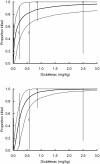Rate of decline of the Oriental white-backed vulture population in India estimated from a survey of diclofenac residues in carcasses of ungulates
- PMID: 17668064
- PMCID: PMC1930156
- DOI: 10.1371/journal.pone.0000686
Rate of decline of the Oriental white-backed vulture population in India estimated from a survey of diclofenac residues in carcasses of ungulates
Abstract
The non-steroidal anti-inflammatory drug diclofenac is a major cause of the rapid declines in the Indian subcontinent of three species of vultures endemic to South Asia. The drug causes kidney failure and death in vultures. Exposure probably arises through vultures feeding on carcasses of domesticated ungulates treated with the drug. However, before the study reported here, it had not been established from field surveys of ungulate carcasses that a sufficient proportion was contaminated to cause the observed declines. We surveyed diclofenac concentrations in samples of liver from carcasses of domesticated ungulates in India in 2004-2005. We estimated the concentration of diclofenac in tissues available to vultures, relative to that in liver, and the proportion of vultures killed after feeding on a carcass with a known level of contamination. We assessed the impact of this mortality on vulture population trend with a population model. We expected levels of diclofenac found in ungulate carcasses in 2004-2005 to cause oriental white-backed vulture population declines of 80-99% per year, depending upon the assumptions used in the model. This compares with an observed rate of decline, from road transect counts, of 48% per year in 2000-2003. The precision of the estimate based upon carcass surveys is low and the two types of estimate were not significantly different. Our analyses indicate that the level of diclofenac contamination found in carcasses of domesticated ungulates in 2004-2005 was sufficient to account for the observed rapid decline of the oriental white-backed vulture in India. The methods we describe could be used again to assess changes in the effect on vulture population trend of diclofenac and similar drugs. In this way, the effectiveness of the recent ban in India on the manufacture and importation of diclofenac for veterinary use could be monitored.
Conflict of interest statement
Figures




Similar articles
-
Diclofenac residues in carcasses of domestic ungulates available to vultures in India.Environ Int. 2007 Aug;33(6):759-65. doi: 10.1016/j.envint.2007.02.010. Epub 2007 Apr 16. Environ Int. 2007. PMID: 17433834
-
Residues of Diclofenac in Tissues of Vultures in India: A Post-ban Scenario.Arch Environ Contam Toxicol. 2018 Feb;74(2):292-297. doi: 10.1007/s00244-017-0480-z. Epub 2017 Nov 20. Arch Environ Contam Toxicol. 2018. PMID: 29159701
-
Diclofenac disposition in Indian cow and goat with reference to Gyps vulture population declines.Environ Pollut. 2007 May;147(1):60-5. doi: 10.1016/j.envpol.2006.08.017. Epub 2006 Oct 25. Environ Pollut. 2007. PMID: 17069941
-
Dropping dead: causes and consequences of vulture population declines worldwide.Ann N Y Acad Sci. 2012 Feb;1249:57-71. doi: 10.1111/j.1749-6632.2011.06293.x. Epub 2011 Dec 16. Ann N Y Acad Sci. 2012. PMID: 22175274 Review.
-
The veterinary use of diclofenac and vulture conservation in Spain: Updated evidence and socio-ecological implications.Sci Total Environ. 2021 Nov 20;796:148851. doi: 10.1016/j.scitotenv.2021.148851. Epub 2021 Jul 3. Sci Total Environ. 2021. PMID: 34271379 Review.
Cited by
-
The population decline of Gyps vultures in India and Nepal has slowed since veterinary use of diclofenac was banned.PLoS One. 2012;7(11):e49118. doi: 10.1371/journal.pone.0049118. Epub 2012 Nov 7. PLoS One. 2012. PMID: 23145090 Free PMC article.
-
Avian scavengers and the threat from veterinary pharmaceuticals.Philos Trans R Soc Lond B Biol Sci. 2014 Nov 19;369(1656):20130574. doi: 10.1098/rstb.2013.0574. Philos Trans R Soc Lond B Biol Sci. 2014. PMID: 25405963 Free PMC article.
-
Toxicity of non-steroidal anti-inflammatory drugs to Gyps vultures: a new threat from ketoprofen.Biol Lett. 2010 Jun 23;6(3):339-41. doi: 10.1098/rsbl.2009.0818. Epub 2009 Dec 9. Biol Lett. 2010. PMID: 20007163 Free PMC article.
-
Molecular sexing of threatened Gyps vultures: an important strategy for conservation breeding and ecological studies.Springerplus. 2012 Dec;1(1):62. doi: 10.1186/2193-1801-1-62. Epub 2012 Dec 12. Springerplus. 2012. PMID: 23316450 Free PMC article.
-
Effectiveness of action in India to reduce exposure of Gyps vultures to the toxic veterinary drug diclofenac.PLoS One. 2011 May 11;6(5):e19069. doi: 10.1371/journal.pone.0019069. PLoS One. 2011. PMID: 21589920 Free PMC article.
References
-
- Prakash V, Pain DJ, Cunningham AA, Donald PF, Prakash N, et al. Catastrophic collapse of Indian white-backed Gyps bengalensis and long-billed Gyps indicus vulture populations. Biological Conservation. 2003;109:381–390.
-
- Green RE, Newton I, Shultz S, Cunningham AA, Gilbert M, et al. Diclofenac poisoning as a cause of vulture population declines across the Indian subcontinent. Journal of Applied Ecology. 2004;41:793–800.
-
- Gilbert M, Watson RT, Virani MZ, Oaks JL, Ahmed S, et al. Rapid population declines and mortality clusters in three Oriental white-backed vulture Gyps bengalensis colonies in Pakistan due to diclofenac poisoning. Oryx. 2006;40:388–399.
-
- IUCN. 2006. 2006 IUCN Red List of Threatened Species. http://www.iucnredlist.org/ via the Internet. Downloaded on 26 April 2007.
-
- Oaks JL, Gilbert M, Virani MZ, Watson RT, Meteyer CU, et al. Diclofenac residues as the cause of vulture population declines in Pakistan. Nature. 2004;427:630–633. - PubMed
Publication types
MeSH terms
Substances
LinkOut - more resources
Full Text Sources

